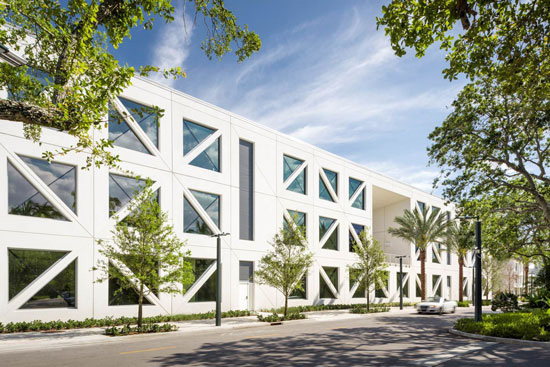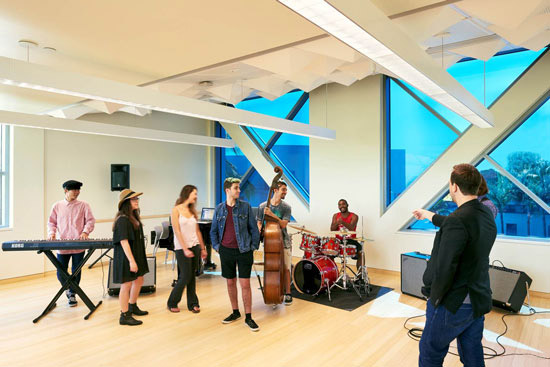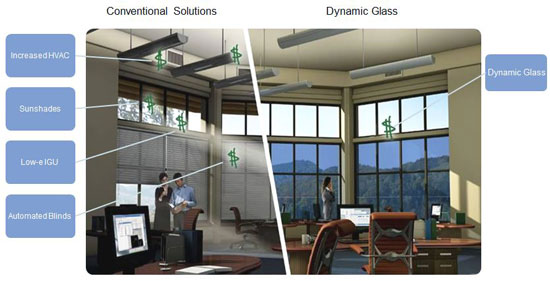The Health and Design Benefits of Accessing Daylight and Views with Dynamic Glass
Freedom to Design with Glass
EC glass enables designers to use more glass in their designs without the comfort or energy penalty so commonly associated with increasing the amount of glazing on a building envelope. This solution enables designers to think of glass in a new light. It is now a self-contained, above-code source of daylight and daylight control.
In terms of practicality, EC glass doesn’t require any additional interior shades or exterior shading devices. It can be installed on difficult-to-shade complex sloped facades (as seen in description of the Butler County Health Care facility on page 2), in non-rectangular shapes (as demonstrated on the Frost School of Music), in structural glazing applications, or in a never-before-seen architectural inspiration. EC glass enables designers to go wild with glass, without worrying about heat gain or glare showing up. It is not invited.
In addition, expanded aesthetic offerings provides designers with more options to find the perfect color to complement any design. EC glass on standard clear glass substrates is now available with an improved exterior reflected color aesthetic. The slightly reflective blue-green reflected color complements a number of static solar control glass products, such as double silver and triple silver low-e coatings on clear glass, adding an aesthetic depth and curb appeal to the building facade that was not previously possible with the first generation of EC products.


Photos courtesy of Moris Moreno
The Frost School of Music in Miami featuring 5-by-10 foot triangular-shaped EC glass with an architecturally favored exterior blue-green color aesthetic.
An EC coating can now also be applied to a range of tinted glass substrates, which can provide a variety of colors to complement the unique aesthetic of a project. Blues, greens, grays as well as the standard improved clear options are available.
The Payback of EC Glass
Building owners will always ask about the payback for investing in an EC glass system because they think the cost will be higher than the conventional solution. In order to answer that question, we first have to understand what solution would have been used to meet the sun management needs (the base case). That allows us to do an upfront capital cost comparison (shown in Figure 2). For that, we have to consider all aspects of the base case—the glass, the exterior shading, interior blinds and the cost of the HVAC system capacity. These costs are not always accounted for in the same budget areas. For example, blinds may be in the interiors budget, not in the core and shell budget. Reductions in HVAC capacity when using EC glass can amount to significant savings as well.

Image courtesy of SageGlass
Figure 2: In order to determine the payback on investing in an EC solution, the total cost of the originally considered conventional sun management solution must be determined.
When comparing an EC glass solution to a conventional solution base case containing high-performance static glass, exterior sunshades, and automated shades, the upfront installed cost of an electrochromic solution is about the same. In this case, there is little or no payback question to answer since the investment cost is the same as the base case and the owner continues to accrue all the benefits of improved occupant comfort and energy performance during the life of the building.
If the original design was only destined to feature regular static solar control glass and a manually controlled blind, a rather low-performing system, there will be an up-front cost differential. In this case, a discussion on payback is needed. When looking at the costs of running a building, consider that the energy costs are about one percent of the total, and the cost of people amounts to 90 percent. So when looking at payback, small increases in occupant productivity, attendance, attraction, and retention that providing a well day-lit, comfortable environment can certainly achieve, will quickly dwarf any financial benefits from energy savings. Increasing productive time by only two percent, which amounts to only 10 minutes more each day focused on the primary task, could save hundreds of thousands of dollars annually on human resource costs. This can make for a rapid payback on the initial investment. One could also ask the question another way: What is the cost of not investing in a dynamic solution and causing occupants to be uncomfortable and unproductive in the space?
EC glass can produce significantly higher paybacks with even small changes in productivity and absenteeism. EC glass can also generate significant energy savings through effectively managing solar heat gain and reducing the load on the HVAC system throughout the year.
Today, it is more evident than ever before that incorporating controlled daylight and views in an interior generates significant benefit to the health, well-being, and productivity of people in the space. Now, with EC glass, designers can think of glass as a self-contained manager of that valuable daylight exposure and view, enabling highly glazed spaces to be created without compromising occupant comfort or energy performance. Designing spaces to be healthy, productive, and energy efficient has never been easier.
 |
SageGlass®, a product of Saint-Gobain, is advanced dynamic glass that can be electronically tinted or cleared to optimize daylight and improve the human experience in buildings. With SageGlass you can control sunlight and glare without shades or blinds while maintaining the view and connection to the outdoors. SageGlass is manufactured in Faribault, MN, in the heart of the “Silicon Valley of the window industry,” and is a wholly owned subsidiary of Saint-Gobain of Paris, the world's largest building materials company. www.sageglass.com |








